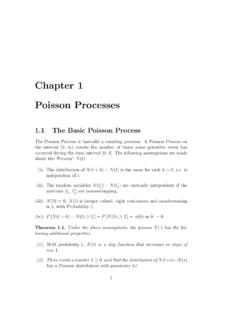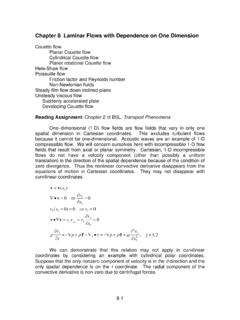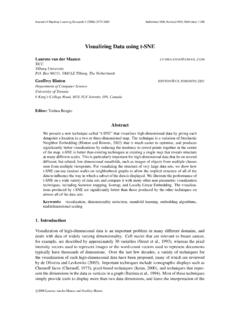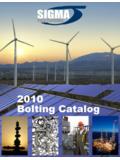Transcription of High-frequency trading in a limit order book
1 Quantitative Finance, Vol. 8, No. 3, April 2008, 217 224. Downloaded By: [Mt Sinai School of Medicine, Levy Library] At: 23:19 28 April 2008. High-frequency trading in a limit order book MARCO AVELLANEDA and SASHA STOIKOV*. Mathematics, New York University, 251 Mercer Street, New York, NY 10012, USA. (Received 24 April 2006; in final form 3 April 2007). 1. Introduction inventory risk arising from uncertainty in the asset's value and (ii) the asymmetric information risk arising from The role of a dealer in securities markets is to provide informed traders. Useful surveys of their results can liquidity on the exchange by quoting bid and ask prices be found in Biais et al.
2 (2004), Stoll (2003) and a book by at which he is willing to buy and sell a specific quantity of O'Hara (1997). In this paper, we will focus on the assets. Traditionally, this role has been filled by market- inventory effect. In fact, our model is closely related to a maker or specialist firms. In recent years, with the growth paper by Ho and Stoll (1981), which analyses the optimal of electronic exchanges such as Nasdaq's Inet, anyone prices for a monopolistic dealer in a single stock. In their willing to submit limit orders in the system can effectively model, the authors specify a true' price for the asset, play the role of a dealer.
3 Indeed, the availability of high and derive optimal bid and ask quotes around this price, frequency data on the limit order book (see to account for the effect of the inventory. This inventory com) ensures a fair playing field where various agents can effect was found to be significant in an empirical study post limit orders at the prices they choose. In this paper, of AMEX Options by Ho and Macris (1984). In another we study the optimal submission strategies of bid and ask paper by Ho and Stoll (1980), the problem of dealers orders in such a limit order book. under competition is analysed and the bid and ask prices The pricing strategies of dealers have been studied are shown to be related to the reservation (or indifference).
4 Extensively in the microstructure literature. The two most prices of the agents. In our framework, we will assume often addressed sources of risk facing the dealer are (i) the that our agent is but one player in the market and the true' price is given by the market mid-price. Of crucial importance to us will be the arrival rate of *Corresponding author. Email: buy and sell orders that will reach our agent. In order Quantitative Finance ISSN 1469 7688 print/ISSN 1469 7696 online 2008 Taylor & Francis DOI: 218 Feature Downloaded By: [Mt Sinai School of Medicine, Levy Library] At: 23:19 28 April 2008.
5 To model these arrival rates, we will draw on recent results stock evolves according to in econophysics. One of the important achievements of dSu dWu 1 . this literature has been to explain the statistical properties of the limit order book (see Bouchaud et al. 2002, with initial value St s. Here Wt is a standard one- Luckock 2003, Potters and Bouchaud 2003, Smith et al. dimensional Brownian motion and is 2003). The focus of these studies has been to reproduce Underlying this continuous-time model is the implicit the observed patterns in the markets by introducing zero assumption that our agent has no opinion on the drift or intelligence' agents, rather than modelling optimal stra- any autocorrelation structure for the stock.
6 Tegies of rational agents. One possible exception is the This mid-price will be used solely to value the agent's work of Luckock (2003), who defines a notion of optimal assets at the end of the investment period. He may not strategies, without resorting to utility functions. Though trade costlessly at this price, but this source of random- our objective is different to that of the econophysics ness will allow us to measure the risk of his inventory in literature, we will draw on their results to infer reasonable stock. In section we will introduce the possibility to arrival rates of buy and sell orders.
7 In particular, trade through limit orders. the results that will be most useful to us are the size distribution of market orders (Maslow and Mills 2001, Weber and Rosenow 2005, Gabaix et al. 2006) and the The optimizing agent with finite horizon temporary price impact of market orders (Bouchaud et al. 2002, Weber and Rosenow 2005). The agent's objective is to maximize the expected Our approach, therefore, is to combine the utility exponential utility of his P&L profile at a terminal framework of the Ho and Stoll approach with the time T. This choice of convex risk measure is particularly microstructure of actual limit order books as described convenient, since it will allow us to define reservation in the econophysics literature.
8 The main result is that the (or indifference) prices which are independent of the optimal bid and ask quotes are derived in an intuitive agent's wealth. two-step procedure. First, the dealer computes a personal We first model an inactive trader who does not have indifference valuation for the stock, given his current any limit orders in the market and simply holds an inventory. Second, he calibrates his bid and ask quotes to inventory of q stocks until the terminal time T. the limit order book, by considering the probability with This frozen inventory' strategy will later prove to be which his quotes will be executed as a function of their useful in the case when limit orders are allowed.
9 Distance from the mid-price. In the balancing act between The agent's value function is the dealer's personal risk considerations and the market environment lies the essence of our solution. v x, s, q, t Et exp x qST , The paper is organized as follows. In section 2, we where x is the initial wealth in dollars. This value function describe the main building blocks for the model: the can be written as dynamics of the mid-market price, the agent's utility 2 2 2 . objective and the arrival rate of orders as a function of q T t . v x, s, q, t exp x exp qs exp , the distance to the mid-price. In section 3, we solve for 2.
10 The optimal bid and ask quotes, and relate them to the 3 . reservation price of the agent, given his current inventory. We then present an approximate solution, numerically which shows us directly its dependence on the market simulate the performance of our agent's strategy parameters. and compare its Profit and Loss (P&L) profile to that We may now define the reservation bid and ask prices of a benchmark strategy. for the agent. The reservation bid price is the price that would make the agent indifferent between his current portfolio and his current portfolio plus one stock. The reservation ask price is defined similarly below.














